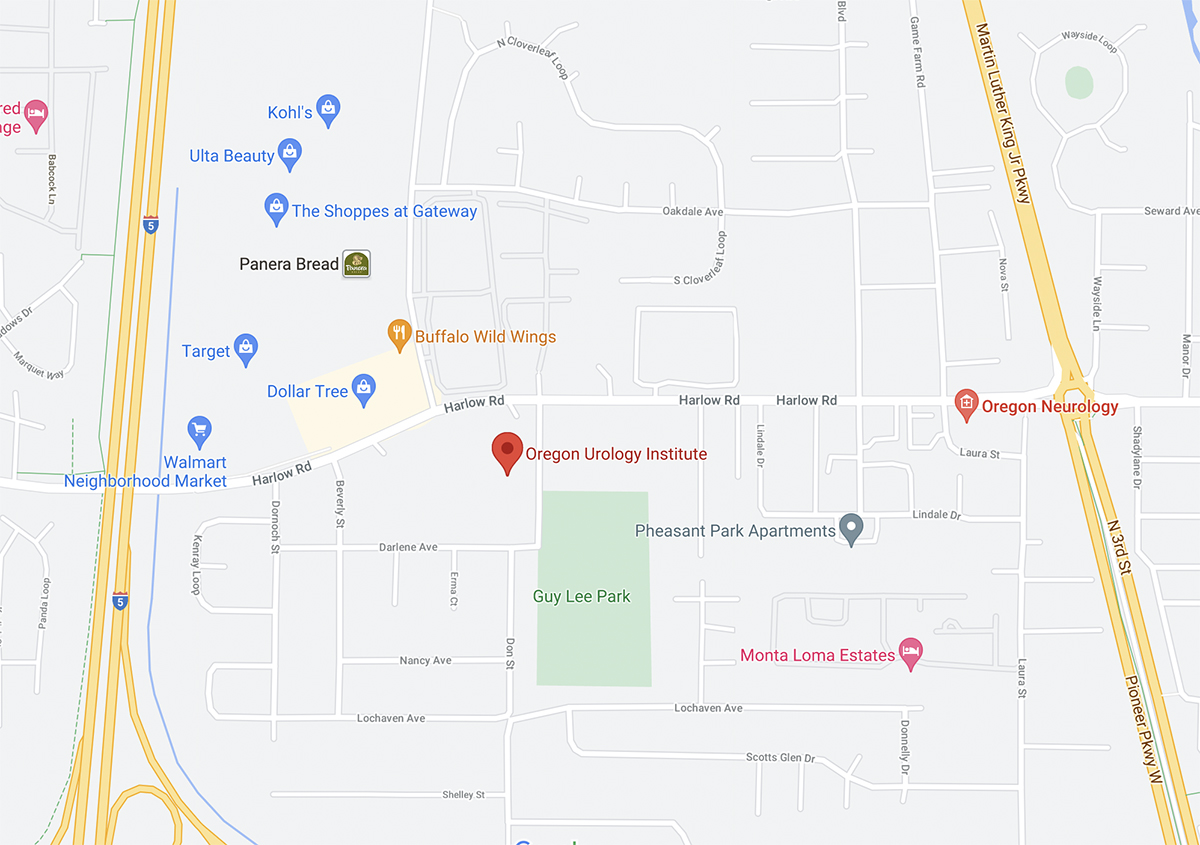SURGERY

EXPERIENCED
SURGEONS
The doctors at Oregon Urology Institute offer many surgery options to specifically treat urological conditions. Below is a list of some of the most common surgeries that are performed in Oregon Urology Institute’s Surgi Center and at other local medical clinics and hospitals.
ACTIVE SURVEILLANCE
One in six men will test positive for prostate cancer. If you are one of them, you and your doctor may choose active surveillance instead of treatment like prostate surgery. If you choose active surveillance, your doctor will monitor your condition, test regularly and watch for any signs that the disease is changing. You may change your mind and decide to have treatment at any time during active surveillance.
Men choose active surveillance for many reasons. Some early-stage prostate cancers grow very slowly and never cause problems or become life-threatening. When this is the case, active surveillance avoids the harm treatment can cause without shortening your life.
You may also choose active surveillance if you are older or have other health issues. If you are in your 70’s or 80’s, you may have different views about undergoing surgery or radiation than you would if you were younger.
Your doctor will explain all of your options and help you choose a strategy that fits your needs.
ARTERIAL EMBOLIZATION
CYSTECTOMY
About Cystectomy
A cystectomy is the surgical removal of all (simple or radical cystectomy) or part (segmental cystectomy) of the bladder. The procedure is done when bladder cancer has spread into the bladder wall or when other treatments have not been successful. Depending on how much of your bladder is removed, your doctor may need to create a new way for urine to leave your body. This is called urinary diversion.
Learn more about different types of cystectomy:
Segmental Cystectomy
Segmental cystectomy is a surgery to remove part of your bladder. If cancer has spread to your bladder wall but is limited to one area, your doctor may recommend a segmental cystectomy.
Because a segmental cystectomy removes only part of the bladder, most people are able to urinate normally after recovery.
Simple Cystectomy
A simple cystectomy is the removal of the entire bladder. If cancer has spread to numerous places in your bladder wall, or is near the openings where urine enters or leaves the bladder, a simple cystectomy may be needed to prevent it from spreading further.
Because a simple cystectomy removed the bladder, your doctor will create an alternate way for urine to leave your body. This is called urinary diversion.
Radical Cystectomy
If bladder cancer is advanced and has spread to the muscle wall or beyond, a radical cystectomy may be done. In a radical cystectomy, the entire bladder and any nearby lymph nodes and organs to which the cancer has spread may be removed.
In men, this may include the prostate and seminal vesicles. In women, it may include the uterus, ovaries and part of the vagina. Sometimes, if cancer has spread beyond the bladder and can’t be removed, the bladder may still be removed to reduce urinary symptoms caused by the cancer.
Because a simple cystectomy removed the bladder, your doctor will create an alternate way for urine to leave your body. This is called urinary diversion.
FEMALE RECONSTRUCTION
LAPARASCOPIC SURGERY
Laparascopic surgery is a minimally-invasive surgery technique using plastic tubes, a small video camera and thin instruments. Your surgeon will make small incisions and insert plastic tubes into your body. He can then insert the camera, which helps him guide thin hand-held instruments through the ports to complete the procedure.
NEPHRECTOMY
About Nephrectomy
A nephrectomy is the surgical removal of all (simple or radical nephrectomy) or part (partial nephrectomy) of the kidney. The procedure is done to treat kidney cancer or to remove a seriously damaged kidney.
You have two kidneys and can live with part of one working kidney. If both kidneys are removed, you will need a kidney transplant or dialysis. During dialysis, a machine cleans your blood outside your body. If a nephrectomy is not possible, your doctor may recommend an arterial embolization to shrink the tumor.
Learn more about different types of nephrectomy:
Partial Nephrectomy
Partial nephrectomy is a surgery to remove part of your kidney when cancer is limited to one area. If one of your kidneys is damaged or has already been removed, your doctor may recommend a partial nephrectomy to try to retain function in the remaining kidney.
Simple Nephrectomy
A simple nephrectomy is the removal of an entire kidney. If cancer has spread throughout your kidney, your doctor may recommend a simple nephrectomy. If your remaining kidney is healthy, you will not need dialysis or a transplant.
Radical Nephrectomy
If cancer has spread beyond your kidney into surrounding lymph nodes and tissue, you may need a radical nephrectomy. In a radical nephrectomy, the kidney, adrenal gland, surrounding tissue and lymph nodes may be removed to prevent the cancer from spreading further. If your remaining kidney is healthy, you will not need dialysis or a transplant.
PROSTATECTOMY
About Prostatectomy
A prostatectomy is a prostate surgery to remove all or part of the prostate gland to remove prostate cancer. Surgery is usually offered as a treatment option for men who are otherwise healthy.
Radical Perineal Prostatectomy
In a radical perineal prostatectomy, the prostate is removed through an incision made in the perineum, the area between your anus and scrotum. The recovery time for a perineal prostatectomy is usually shorter than a retropubic prostatectomy.
Radical Retropubic Prostatectomy
A radical retropubic prostatectomy is the surgical removal of the prostate by means of a “retropubic approach.” This means that your prostate will be removed through an incision in your pelvis above the pubic bone in front of the bladder. Your doctor may also remove and test lymph nodes from the area to make sure the cancer has not spread.
Robotic-Assisted Prostatectomy
Robotic-assisted prostatectomy is a minimally-invasive surgery to remove the prostate. Using robotic arms that translate your surgeon’s hand motions into very precise actions, small incisions are made in the layers of your tissue to remove the prostate and surrounding tissue if needed.
RADICAL INGUINAL ORCHIECTOMY
Radical inguinal orchiectomy is a surgical procedure to remove one or both of your testicles. It is usually used to remove testicular cancer, but is sometimes also used as a hormone therapy to treat prostate cancer. During an orchiectomy, a small incision is made in your abdomen. Your testicle is pushed up from the scrotum through the incision and removed. The procedure is usually finished in less than an hour and most people are able to go home the same day.
ROBOTIC SURGERY
Robotic surgery is a minimally-invasive surgery technique using a computer that remotely controls small instruments attached to robotic arms. The small instruments mean that incisions in your body can be much smaller than those needed for standard surgery using hand-held tools.
Once inside your body, a thin tube with a camera attached allows your surgeon to view magnified images of the inside of your body in real-time. He can then make the necessary movements and cuts using the computer to translate his hand motions into very precise actions.
URINARY DIVERSION
If your bladder cancer requires a simple or radical cystectomy, your doctor will need to create a new way for urine to pass from your body.
He may create a bypass system that allows urine to flow directly from your kidneys to a plastic bag on the outside of your body. This is done by creating a tube that attaches to your ureters to an opening in your abdomen.
Alternately, he may create a new reservoir that is attached inside your pelvis. This will allow you to control when you urinate. If your urethra is intact, you will urinate much like you did before your surgery. If your urethra was removed, the reservoir will be attached to a thin tube through an opening in your abdomen.
VASECTOMY
A vasectomy is a minor outpatient surgery that interrupts the flow of sperm from the testicles to the penis. It is usually an elective procedure men choose to have done as a means of permanent birth control. A vasectomy will not affect your sex drive, ability to get an erection, sensation of orgasm or ability to ejaculate.
How It Works
There are two types of vasectomies: conventional and non-scalpel. In a conventional vasectomy, as small piece of the tube that connects your testicles to your penis is removed through two small incisions in your scrotum. A no-scalpel vasectomy uses a special instrument to puncture your skin and lift out the tube so it can be cauterized or tied.
Side Effects
After your vasectomy, your scrotum will be numb for one to two hours. You may have some swelling or minor pain in your scrotum for several days after surgery, but unless your work is strenuous, you should be able to return to work in a day or two. You may also have mild aching in your testicles during arousal for a few months after surgery.
Immediately after your surgery, try to lie on your back as much as possible for the rest of the day. Apply cold packs to the area of your scrotum and wear snug underwear or a jock strap for support to relieve discomfort.
You can resume sexual intercourse when it’s comfortable for you, usually in about a week. You should continue to use a backup method of contraception until your doctor confirms that your sperm count is zero.






